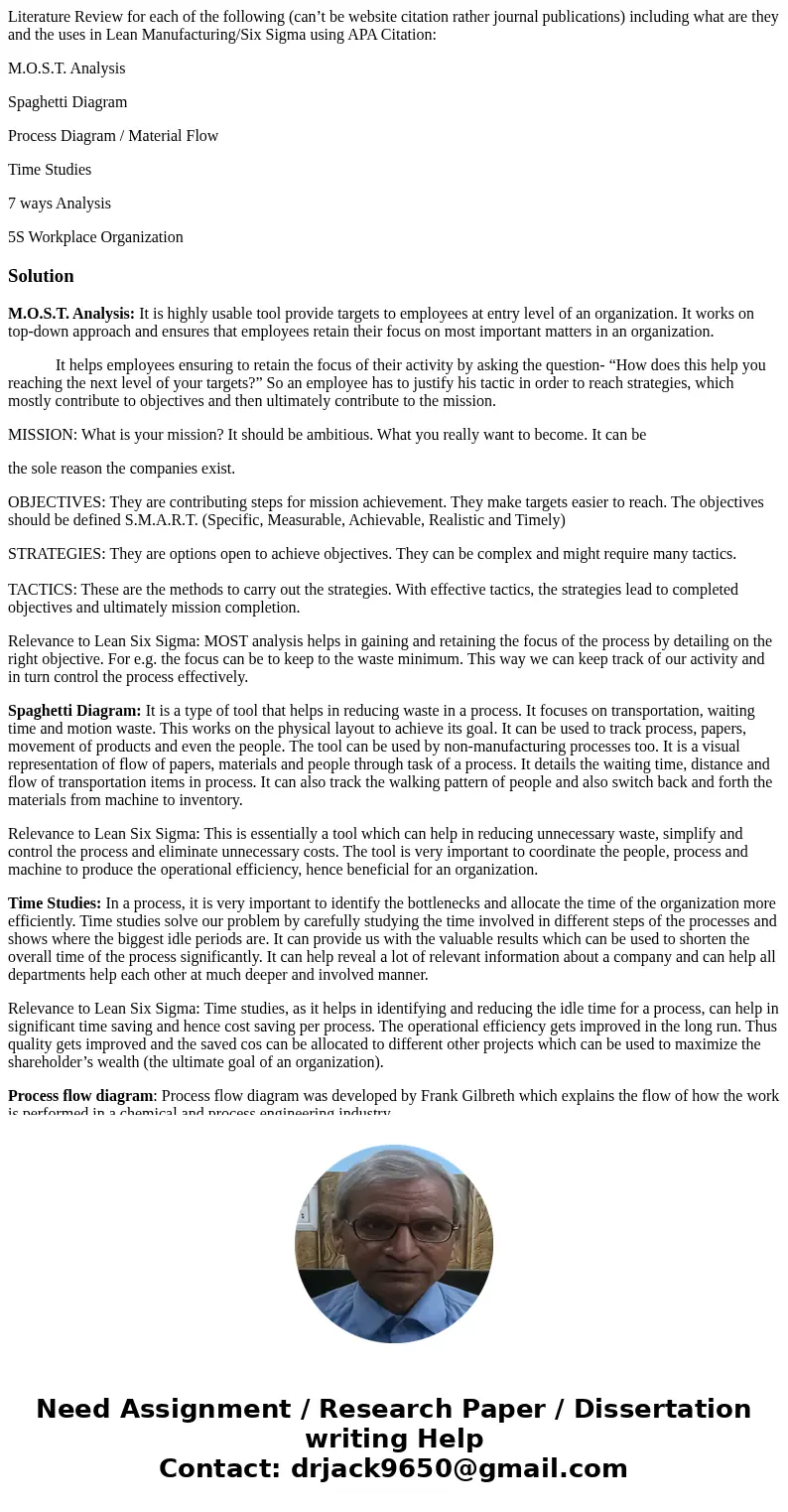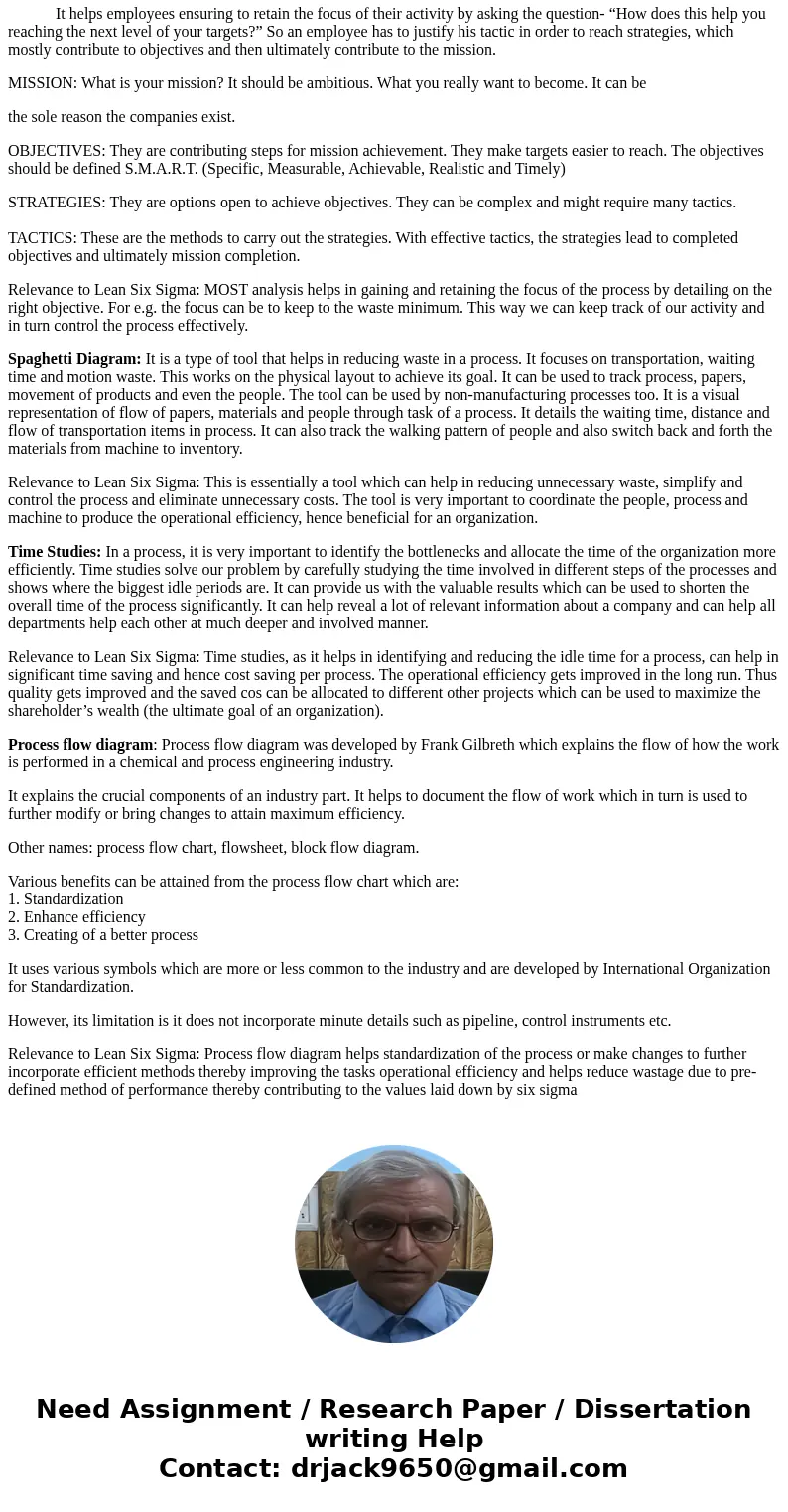Literature Review for each of the following cant be website
Literature Review for each of the following (can’t be website citation rather journal publications) including what are they and the uses in Lean Manufacturing/Six Sigma using APA Citation:
M.O.S.T. Analysis
Spaghetti Diagram
Process Diagram / Material Flow
Time Studies
7 ways Analysis
5S Workplace Organization
Solution
M.O.S.T. Analysis: It is highly usable tool provide targets to employees at entry level of an organization. It works on top-down approach and ensures that employees retain their focus on most important matters in an organization.
It helps employees ensuring to retain the focus of their activity by asking the question- “How does this help you reaching the next level of your targets?” So an employee has to justify his tactic in order to reach strategies, which mostly contribute to objectives and then ultimately contribute to the mission.
MISSION: What is your mission? It should be ambitious. What you really want to become. It can be
the sole reason the companies exist.
OBJECTIVES: They are contributing steps for mission achievement. They make targets easier to reach. The objectives should be defined S.M.A.R.T. (Specific, Measurable, Achievable, Realistic and Timely)
STRATEGIES: They are options open to achieve objectives. They can be complex and might require many tactics.
TACTICS: These are the methods to carry out the strategies. With effective tactics, the strategies lead to completed objectives and ultimately mission completion.
Relevance to Lean Six Sigma: MOST analysis helps in gaining and retaining the focus of the process by detailing on the right objective. For e.g. the focus can be to keep to the waste minimum. This way we can keep track of our activity and in turn control the process effectively.
Spaghetti Diagram: It is a type of tool that helps in reducing waste in a process. It focuses on transportation, waiting time and motion waste. This works on the physical layout to achieve its goal. It can be used to track process, papers, movement of products and even the people. The tool can be used by non-manufacturing processes too. It is a visual representation of flow of papers, materials and people through task of a process. It details the waiting time, distance and flow of transportation items in process. It can also track the walking pattern of people and also switch back and forth the materials from machine to inventory.
Relevance to Lean Six Sigma: This is essentially a tool which can help in reducing unnecessary waste, simplify and control the process and eliminate unnecessary costs. The tool is very important to coordinate the people, process and machine to produce the operational efficiency, hence beneficial for an organization.
Time Studies: In a process, it is very important to identify the bottlenecks and allocate the time of the organization more efficiently. Time studies solve our problem by carefully studying the time involved in different steps of the processes and shows where the biggest idle periods are. It can provide us with the valuable results which can be used to shorten the overall time of the process significantly. It can help reveal a lot of relevant information about a company and can help all departments help each other at much deeper and involved manner.
Relevance to Lean Six Sigma: Time studies, as it helps in identifying and reducing the idle time for a process, can help in significant time saving and hence cost saving per process. The operational efficiency gets improved in the long run. Thus quality gets improved and the saved cos can be allocated to different other projects which can be used to maximize the shareholder’s wealth (the ultimate goal of an organization).
Process flow diagram: Process flow diagram was developed by Frank Gilbreth which explains the flow of how the work is performed in a chemical and process engineering industry.
It explains the crucial components of an industry part. It helps to document the flow of work which in turn is used to further modify or bring changes to attain maximum efficiency.
Other names: process flow chart, flowsheet, block flow diagram.
Various benefits can be attained from the process flow chart which are:
1. Standardization
2. Enhance efficiency
3. Creating of a better process
It uses various symbols which are more or less common to the industry and are developed by International Organization for Standardization.
However, its limitation is it does not incorporate minute details such as pipeline, control instruments etc.
Relevance to Lean Six Sigma: Process flow diagram helps standardization of the process or make changes to further incorporate efficient methods thereby improving the tasks operational efficiency and helps reduce wastage due to pre-defined method of performance thereby contributing to the values laid down by six sigma


 Homework Sourse
Homework Sourse